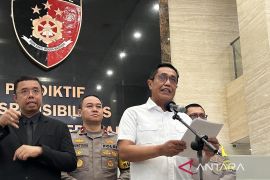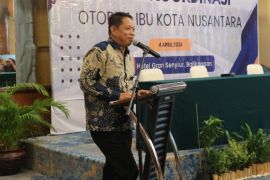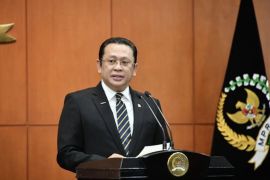According to the National Language Centre at the Ministry of Education and Culture, Indonesia is home to more than 746 ethnic languages.
Unfortunately, it is predicted that about 90 percent of these ethnic languages will disappear by the end of the 21st century because the number of speakers is shrinking rapidly.
The ethnic languages in Indonesia belong to both the Austronesian or Malay-speaking families, and non-Austronesian or Trans-New Guinea-speaking families.
Particularly, the languages in the eastern part of Indonesia are classified as languages of the minority because of a sharp decrease in the number of speakers, and the endangered Oirata language is one of them.
This language is spoken by the people of Oirata Barat and Oirata Timur villages on the island of Kisar, Southwest Maluku (MBD) District, Maluku.
Based on the results of the 2010 census, these two villages have a total population of 1,566, but only a few of them are able to communicate in the Oirata language, while the rest communicate in the Ambonese Malay dialect.
In reality, less than 500 people above the age of 50 are able to communicate well in the Oirata language while their children and grandchildren are unable to do so.
"If nothing is done, the Oirata language is feared to become extinct," said Prof. Tanwey Gerson Ratumanan, who works at Ambon Pattimura University (Unpatti).
He added that the Oirata language is at risk of becoming extinct as less than 500 people speak the language, while the rest are shifting to Ambonese Malay language.
With the extinction of this language, the villages of Oirata Barat and Oirata Timur will not only lose their cultural wealth but also important ancestral knowledge.
Ratumanan noted that the extinction of the Oirata language could result in the disappearance of local traditions such as corporate values, rules, norms, customs, and habits.
He then asserted that the endangered Oirata language should be preserved and maintained, and this is possible if adults in the two villages teach the language and culture to their children and grandchildren.
Therefore, through the development and protection of cultural heritage, as part of the national priority, the Indonesian Institute of Sciences (LIPI) is working hard to document the Oirata language and prevent it from becoming extinct.
"Through the documentation of Oirata language, we hope that the government and language observers will ensure its survival," said Soewarsono, a researcher at LIPI, during a seminar on the "Revitalisation of Oirata Language" in Ambon, Maluku, recently.
According to him, the seminar, attended by various parties from Oirata Barat and Oirata Timur villages and speakers from LIPI and Unpatti, aims to find a solution to prevent the Oirata language from becoming extinct.
Soewarsono pointed out that according to UNESCO`s Ad Hoc Group on Endangered Languages, there are nine factors that can determine the viability of a language, its function in society, and the type of measures required for its maintenance or revitalisation.
Among the nine factors are inter-generational language transmission, absolute number of speakers and proportion of speakers within the total population, and amount and quality of documentation.
Based on a study, Soewarsono found that inter-generational language transmission and the proportion of speakers within the total population are declining.
"We also found that speakers above the age of 50 continue to switch from Oirata language to Ambon Malay dialect when speaking to their children and grandchildren at home," said Sowarsono.
However, he mentioned that language plays an important role in the social structure of the Oirata people because every clan in the two villages has its own unique myth that can be told in the Oirata language during the customary system of marriage.
"However, the number of speakers in the customary system of marriage is reducing drastically," Soewarsono went on.
Meanwhile, Nazarudin, a lecturer of linguistics at the University of Indonesia, said the Oirata language has some characteristics and five simple vowel sounds with a few variations of allophone, one of two or more variants of the same phoneme, which also appear in the non-Austronesian languages.
"Therefore, some linguists classify Oirata language under non-Austronesia or Trans-New Guinea language family," he added.
From its structural and grammatical aspects, the Oirata language has a complexity of morphological system with S O V structure in which the verb or the predicate appears at the end of a sentence.
The Oirata language is unique in its structure and usage, and thus, it is sad that its existence is under threat.
Therefore, Nazarudin said this year, his team of researchers will focus on the development of orthography, and the system of spelling, as part of efforts to revitalise the Oirata language.
"During our research this year, we will try to find the best possible solution to the problem of the Oirata language, in an attempt to revitalise and develop the language and culture," he added.
Citing a statement by the Summer Institute of Linguistics (SIL), the linguistics teacher at the University of Indonesia said people`s identity and culture are intimately tied to their language.
He said words that describe a particular cultural practice of idea cannot be translated precisely into another language.
Nazarudin noted that Oirata is one of the many endangered languages, which has a rich oral culture, with stories and myths passed on to the younger generations.
"Thus, if the people of Oirata lose their language, they will lose their culture and their moral substance too," he noted.
Parents in the villages of West and East Oirata are no longer teaching this language to their children and are not using it actively in their everyday conversations.
Nazarudin explained that the development of the orthography of the Oirata language would be the first step in the efforts to preserve the language.
He added that the documentation carried out during their research in the previous years was limited to basic conversation and speech in traditional wedding ceremonies.
"Therefore, this year, we will expand the documentation of the Oirata language into both educational and transactional domains," he said.
Nazarudin added that they have documented the vocabulary of the Oirata language into a dictionary and the structure of the language into a teaching material to be taught at local schools.
According to him, the expansion of the language in these two domains is considered important for the communities of the two villages to be able to interact in their own language.
EDITED BY INE
(KR-BSR/O001)
Reporter: Otniel Tamindael
Editor: Jafar M Sidik
Copyright © ANTARA 2013











